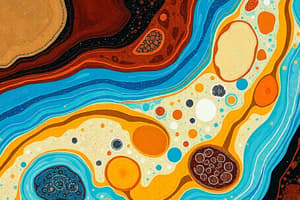Podcast
Questions and Answers
Which type of rock is the most abundant among classified rocks by particle size?
Which type of rock is the most abundant among classified rocks by particle size?
- Limestone
- Conglomerate
- Shale (correct)
- Sandstone
What is the most abundant chemical rock mentioned in the text?
What is the most abundant chemical rock mentioned in the text?
- Jasper
- Flint
- Limestone (correct)
- Chert
Which type of metamorphism occurs near a body of magma?
Which type of metamorphism occurs near a body of magma?
- Regional metamorphism
- Contact metamorphism (correct)
- Pressure metamorphism
- Heat metamorphism
What agent of metamorphism provides the energy needed to drive chemical reactions?
What agent of metamorphism provides the energy needed to drive chemical reactions?
Which rock type is not mentioned in the text as a product of chemical sedimentary rocks?
Which rock type is not mentioned in the text as a product of chemical sedimentary rocks?
Which mineral group is defined as containing silicon and oxygen?
Which mineral group is defined as containing silicon and oxygen?
Which mineral group consists of minerals containing carbon, oxygen, and other metallic elements?
Which mineral group consists of minerals containing carbon, oxygen, and other metallic elements?
Minerals that contain oxygen and usually metals belong to which group?
Minerals that contain oxygen and usually metals belong to which group?
Which mineral group contains a halogen ion and other elements?
Which mineral group contains a halogen ion and other elements?
What is the primary composition of siliceous ooze, a biogenous sediment?
What is the primary composition of siliceous ooze, a biogenous sediment?
Minerals with the element sulfur are classified under which group?
Minerals with the element sulfur are classified under which group?
Which mineral is a major component of hydrogenous sediment formed through direct crystallization in ocean water?
Which mineral is a major component of hydrogenous sediment formed through direct crystallization in ocean water?
Which mineral group includes minerals existing in relatively pure form?
Which mineral group includes minerals existing in relatively pure form?
What process leads to the formation of gas hydrates in oceanic sediments?
What process leads to the formation of gas hydrates in oceanic sediments?
Which type of sediment is produced by dissolving calcium carbonate shells?
Which type of sediment is produced by dissolving calcium carbonate shells?
What is the most economically important salt mentioned in the text?
What is the most economically important salt mentioned in the text?
What is the second most economically valuable resource after petroleum in terms of offshore industries?
What is the second most economically valuable resource after petroleum in terms of offshore industries?
Flashcards are hidden until you start studying
Study Notes
Classification of Rocks
- Shale is the most abundant type of rock classified by particle size
Metamorphism
- Contact metamorphism occurs near a body of magma
- Heat is the agent of metamorphism that provides the energy needed to drive chemical reactions
Chemical Sedimentary Rocks
- Evaporite is the most abundant chemical rock mentioned in the text
- Limestone is not a product of chemical sedimentary rocks
Mineral Groups
- Silicates are minerals that contain silicon and oxygen
- Carbonates are minerals that contain carbon, oxygen, and other metallic elements
- Oxides are minerals that contain oxygen and usually metals
- Halides are minerals that contain a halogen ion and other elements
- Sulfides are minerals that contain the element sulfur
Sediments
- Siliceous ooze, a biogenous sediment, is primarily composed of the skeletons of tiny marine plankton
- Gypsum is a major component of hydrogenous sediment formed through direct crystallization in ocean water
Mineral Resources
- Native elements are a mineral group that includes minerals existing in relatively pure form
- Gas hydrates are formed in oceanic sediments through the process of crystallization under high pressure and low temperature
- Solution sediment is produced by dissolving calcium carbonate shells
- Halite (rock salt) is the most economically important salt mentioned in the text
- Natural gas is the second most economically valuable resource after petroleum in terms of offshore industries
Studying That Suits You
Use AI to generate personalized quizzes and flashcards to suit your learning preferences.




